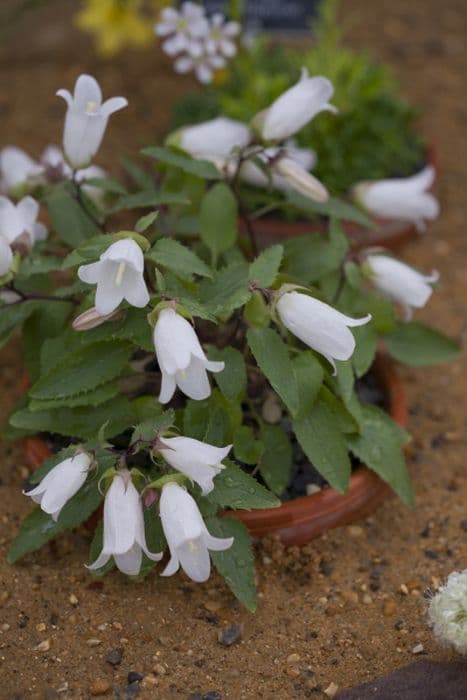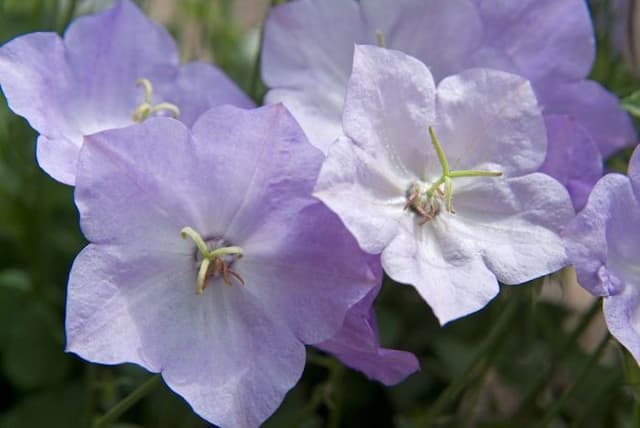Milky Bellflower Campanula lactiflora 'White Pouffe'

ABOUT
The Campanula lactiflora 'White Pouffe' is a charming perennial known for its lush and graceful appearance. This plant is adorned with a profusion of bell-shaped flowers that are a pure, creamy white color. These blossoms are clustered together, forming an attractive, rounded shape that sits atop a bed of foliage. The leaves of the 'White Pouffe' are lance-shaped and have a deep green color that provides a beautiful contrast against the bright whiteness of the flowers. The plant typically blooms in the summer and can continue to produce flowers into the early fall, offering a long season of visual delight. Each flower is comprised of five small petals fused at the base, creating a striking bell-like form that is characteristic of this plant variety. The flowers give off a subtle, enchanting fragrance that can attract butterflies and other pollinators to the garden. Overall, the 'White Pouffe' presents a lush and romantic vibe, with its waves of snowy flowers and rich green foliage. It can serve as an excellent ground cover or as a border plant, and its elegant appearance makes it a desirable addition to mixed perennial beds or as a standalone feature in a garden landscape.
About this plant
 Names
NamesFamily
Campanulaceae.
Synonyms
Milky Bellflower, Caucasian Bellflower, Broad-Leaved Bellflower, Milky Way.
Common names
Campanula lactiflora 'White Pouffe'.
 Toxicity
ToxicityTo humans
The Milky Bellflower is generally considered non-toxic to humans. There are no well-documented cases of poisoning from ingesting this plant, and it is not known to have any toxic substances that would lead to adverse health effects if consumed in typical quantities. Therefore, accidental ingestion is unlikely to cause any significant symptoms. Always exercise caution with plant ingestion and consult with a healthcare provider if you suspect any health issues.
To pets
The Milky Bellflower is not known to be toxic to pets. There are no widespread reports of dogs, cats, or other animals experiencing poisoning after ingesting this plant. It is typically regarded as safe around pets, and ingestion should not lead to any severe symptoms of poisoning. However, it is always advisable to monitor pets to prevent them from eating large quantities of any plant material, which can potentially cause gastrointestinal irritation or other issues. If you notice any unusual signs in your pet after ingestion, consult with a veterinarian.
 Characteristics
CharacteristicsLife cycle
Perennials
Foliage type
Deciduous
Color of leaves
Green
Flower color
White
Height
2 feet (60 cm)
Spread
2 feet (60 cm)
Plant type
Herb
Hardiness zones
5
Native area
Caucasus
Benefits
 General Benefits
General Benefits- Attractive Flowers: Campanula lactiflora 'White Pouffe' produces clusters of bell-shaped, white flowers that can add elegance to garden spaces.
- Pollinator-Friendly: This plant attracts bees, butterflies, and other beneficial pollinators, supporting local ecosystems.
- Long Blooming Period: With a flowering period that lasts from early to late summer, it provides a prolonged display of visual interest.
- Versatile Garden Use: Suitable for borders, cottage gardens, and informal garden settings, adding structure and height where needed.
- Low Maintenance: It is relatively easy to care for, requiring minimal upkeep once established in the right conditions.
- Cold Hardy: The plant is resilient to colder temperatures, making it suitable for a variety of climates.
- Perennial Growth: Being a perennial, it returns each year, providing a reliable feature in the garden landscape.
 Medical Properties
Medical PropertiesThis plant is not used for medical purposes.
 Air-purifying Qualities
Air-purifying QualitiesThis plant is not specifically known for air purifying qualities.
 Other Uses
Other Uses- Culinary garnish: The delicate flowers of the Campanula lactiflora 'White Pouffe' can be used as a decorative garnish for salads and desserts.
- Fabric dye: The blossoms may be boiled to extract a light dye for coloring fabrics.
- Educational tool: The plant can be used in botany classes to teach about plant growth, pollination, and the bellflower family.
- Photography subject: Its striking white blooms against green foliage make the Campanula lactiflora 'White Pouffe' a popular subject for floral photography and art.
- Floral arrangements: The long stems and clustered blooms of Campanula lactiflora 'White Pouffe' make it an excellent choice for inclusion in floral designs and wedding bouquets.
- Livestock feed: In some regions, the plant may be used as an emergency fodder for livestock, though this is not its primary use.
- Natural confetti: Dried petals of the Campanula lactiflora 'White Pouffe' can be used as biodegradable confetti for outdoor celebrations.
- Indicator species: It can serve as an indicator species in gardens, reflecting the health of the ecosystem by its growth and bloom patterns.
- Seed harvesting: Hobbyists may collect seeds from the Campanula lactiflora 'White Pouffe' for trading or conservation purposes.
- Soil erosion control: The plant can help in preventing soil erosion in gardens due to its clumping growth habit.
Interesting Facts
 Feng Shui
Feng ShuiThe Milky Bellflower is not used in Feng Shui practice.
 Zodiac Sign Compitability
Zodiac Sign CompitabilityThe Milky Bellflower is not used in astrology practice.
 Plant Symbolism
Plant Symbolism- Gratitude - Campanula, commonly known as bellflower, often symbolizes gratitude due to its bell shape that resembles someone bowing or acknowledging a kind gesture.
- Constancy - The bellflower represents constancy and perennial faithfulness, reflecting the plant's reliable flowering and long-lasting blooms.
- Unwavering love - The enduring nature of the bellflower's bloom is also seen as a symbol of unwavering and endless love.
- Hope - Its flowers pointing skyward can represent hope and the idea of looking towards the future with optimism.
- Humility - The simple beauty of the bell-shaped flowers may evoke feelings of humility in their modest yet charming appeal.
 Water
WaterThe Milky Bellflower should be watered regularly to keep the soil consistently moist, but not waterlogged. Ideally, water when the top inch of soil feels dry to the touch, which typically means once or twice a week, depending on the climate and weather conditions. Use enough water to ensure that the moisture reaches the root zone; for a medium-sized plant, this might be around 16 ounces per watering. During the growing season in spring and summer, the plant may require more frequent watering, while in the cooler fall and winter months, less frequent watering is necessary.
 Light
LightThe Milky Bellflower thrives in a spot where it can receive full sun to partial shade. The best lighting conditions are achieved when the plant gets morning sunlight and afternoon shade, which helps it grow well without the stress of intense midday rays. Placing it in a location that meets these requirements can result in plentiful blossoms and a healthy plant.
 Temperature
TemperatureThe Milky Bellflower prefers temperate conditions and can generally tolerate a range between 40 degrees Fahrenheit and 80 degrees Fahrenheit. It thrives in an ideal temperature range of 60 to 72 degrees Fahrenheit. While it can survive light frosts, sustained temperatures below 40 degrees Fahrenheit may harm the plant. Ensure the plant is not subjected to extreme heat above 80 degrees Fahrenheit for prolonged periods, as this can stress the plant.
 Pruning
PruningPrune the Milky Bellflower after flowering to promote bushier growth and prevent self-seeding, if desired. Deadheading spent flowers will encourage new blooms. Cut back the foliage by one-third in early spring or after the first flush of flowers has faded. Pruning once or twice per growing season is generally enough to maintain its shape and vigor.
 Cleaning
CleaningAs needed
 Soil
SoilThe Milky Bellflower 'White Pouffe' thrives best in a soil mix that is rich, moist, and well-draining with a pH ranging from neutral to slightly alkaline (pH 6.5-7.5). A good soil mixture can be composed of loamy garden soil, compost, and perlite to improve drainage. Regular mulching can help retain moisture and provide necessary nutrients.
 Repotting
RepottingMilky Bellflowers typically do not require frequent repotting and can be left undisturbed for several years. Repot 'White Pouffe' every 3-4 years to refresh the soil and to divide if the clump becomes too large.
 Humidity & Misting
Humidity & MistingMilky Bellflowers are adaptive to a wide range of humidity levels but prefer moderate conditions. They can tolerate the average humidity levels found outdoors and aren't usually demanding of specific humidity levels when grown in garden settings.
 Suitable locations
Suitable locationsIndoor
Ensure bright indirect light and keep the soil moist.
Outdoor
Plant in part shade, ensure well-drained soil, and water regularly.
Hardiness zone
4-9 USDA
 Life cycle
Life cycleThe 'White Pouffe' variety of Milky Bellflower, or Campanula lactiflora, begins its life cycle as a seed, typically germinating in spring when soil temperatures are conducive to growth. Germination is followed by the seedling stage, where the young plant establishes itself with a set of true leaves and begins to grow a root system. As it matures into a vegetative stage, the Milky Bellflower develops a rosette of foliage and elongates its stems in preparation for flowering. The flowering stage usually occurs in early to mid-summer, presenting tall spikes of white, bell-shaped flowers that attract pollinators and are suitable for cut arrangements. After pollination, the plant sets seed, allowing for dispersal and continuation of the species. In the final stage of its life cycle, the plant may become dormant, particularly in colder climates, retreating to the crown until the next growing season or dying back after several seasons if it is a short-lived perennial.
 Propogation
PropogationPropogation time
Spring to Summer
The popular method for propagating the 'White Pouffe', a variety of the Milky Bellflower, is through basal cuttings. These cuttings should ideally be taken in spring as the new shoots are emerging and are approximately 3 to 4 inches (about 7.5 to 10 cm) long. Choose healthy, vigorous shoots and cut them off near the base using a sharp knife. Remove the lower leaves and dip the base of the cutting in rooting hormone to encourage root growth. Then, plant the cuttings in a moist potting mix, placing them in a warm spot with indirect light. Keep the soil moist but not waterlogged, and in a few weeks, the cuttings should develop roots and can be transplanted to their permanent location.









